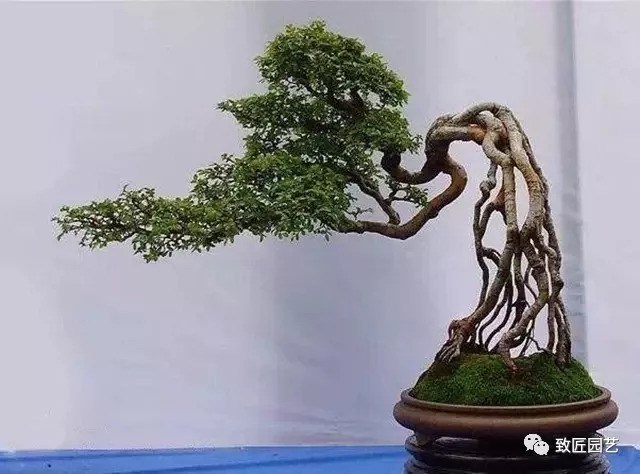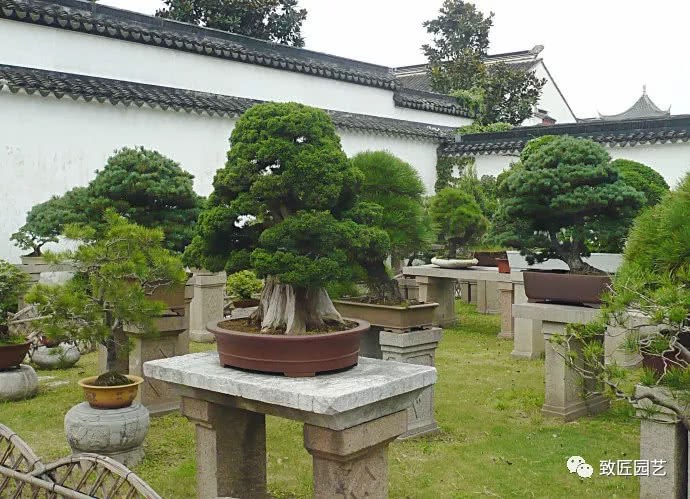On the appreciation and creation of bonsai

Appreciation can make the artistic conception of the work continue and develop, on the contrary, it can enrich and improve the perception ability of appreciation. So it can be said like this: without appreciation, what does it mean to create? In view of this, this paper gives some views on some phenomena in the creation of tree stump bonsai appreciation.
One of the phenomena: "an inch of branches for several years, Jiajing into the calendar ten autumn." This shows the hardship of bonsai creation. However, in this long process of creation, even the master who is determined and confident is difficult to achieve it in one step, and "rework" is inevitable. Even Masahiko Kimura, a giant of Japanese bonsai, is no exception. Otherwise, one of his best cypresses, the tree height 80cm in 1984, why did the tree height drop to 68cm in 1994?
Appreciation and creation advance each other, complement and complement each other. As a matter of fact, there is no creation without appreciation, let alone appreciation without creative practice, just different degrees of appreciation and perception, distinguish the difference between conscious and unconscious appreciation, and exert a subtle influence on the whole process of creation. On the one hand, by appreciating, perceiving nature, drawing lessons from tradition, and absorbing the creative techniques and style characteristics of predecessors or peers, we can make our own creative practice step by step from the exploration stage of imitation production to classification and order; on the other hand, with the exploration and discussion of creative practice, the deepening of experience, the accumulation and deepening of experience, and improve the ability of appreciation and perception. So repeated alternation, layer by layer, gradually make the two to high taste, high realm. In other words, the development of the two is a process of continuous adjustment and rise. If we think calmly, we will make rules, and the process of interest in pile scenery-- mold prevention production-- creative conception-- the process of giving birth to excellent works, generally follows the following rules: first, people start from the appreciation of flowers and trees in nature, and then they follow others and follow suit; and then select a certain school of style and modeling features that are suitable for the subject's interest to be made in a model. Then make horizontal trade-offs, dig longitudinally, learn from others, and apply skills in accordance with their aptitude to reflect the artistic personality of the creation; finally, understand the connotation of excellent works, aesthetic implication, and unique discerning, ingenuity in order to achieve the highest artistic conception of the works.
The second phenomenon: in bonsai appreciation, as connoisseurs, some linger, some watch flowers; in bonsai creation, as creators, some make progress day by day, seek artistic personality in getting rid of themselves, and some stagnate. Falling into the strange circle set by "self" exhausted artistic creativity.
The connoisseur's mentality restricts artistic creativity. For the authors of Zhuangjing, their appreciation is not limited to noble spiritual activities, entertain the body and mind, purify the mind, but more importantly, through the above activities, learn from others' strengths, enhance their strengths and circumvent their weaknesses, and constantly improve their artistic accomplishment, in order to rise abruptly based on their accumulated strength and create excellent works. In fact, however, not everyone can do this. In appreciation activities, we often "split into two" consciously or unconsciously, with our own works on the one hand and works of others other than ourselves on the other. This leads to the tendency of different thoughts, feelings and mentality of appreciation, and leads to different appreciation behaviors and their effects. One of the manifestations is "raising the public and suppressing oneself". With sincerity and pursuit of art, this mentality undoubtedly gives birth to sincerity and objectivity. in the face of the object of appreciation, it is bound to stop and linger and concentrate on appreciation. whether it is the part or the whole, rules or rules, skills or artistic conception, are comprehensively integrated into the category of appreciation activities. Such as the conception of images, the combination of trees, the proportion of modeling, the implementation of techniques, the characteristics of style, the tone of implication, and so on, and try their best to seek the meaning outside the pot. the image outside the scene is able to understand, the good has its origin, and the bad has its reasons, and it is the original intention of round appreciation. Second, on the contrary, "promoting oneself and suppressing the public", my beauty, my supremacy, showing carelessness to other people's works, "looking at flowers on horseback", Ming said appreciation, but in fact contrary to it. The former is healthy and progressive, and its potential artistic creativity is fully mobilized and full of vitality, which can give full play to the re-creative ability of appreciation, while the latter is rigid and stagnant, taking the practice in the exploration stage as the eternal law. Or familiar with the road, urbanization, formulation, conceptualization, in the long run, will eventually lead to the depletion of artistic creativity, resulting in two completely different phenomena.
The third phenomenon: in the appreciation of works, although some tree species and pile cultivation are excellent, their works give people the impression at a glance; while some pile blanks are inconspicuous, and the artistic effects of their works are inexhaustible. Grasping the artistic elements can stimulate the germination of the connoisseur's creativity. In reality, there are many people who pay attention to the advantages and disadvantages of the pile foundation while neglecting the artistic effect. Do not realize that the artistic value of the pile scene does not lie in the value of the variety, the foundation of the pile blank and the size of the potted tree, but in the author's artistic attainments, getting a good pile, which is 50% of success, plus 50% of manual work. This 100% is of course ideal, but the ordinary pile billet can become an excellent work is even more commendable. Mediocre material makes excellent works, the key lies in discovery, lies in creation. Such as: Suren elder elegant and sparse, proud and aloof. Set up an indifferent "life"; Master he Huan-sun's density and momentum created a "world" of life; Master Zhao Qingquan's sparse forest, elegant and fresh, created a quiet "world." throughout the pile blanks in the master's works, they are not necessarily the best people in our eyes. However, the work is of the highest quality. The key lies in the innovation in Pingzhong, the wonder in Pingzhong, the display of skills in Pingzhong, and the rhyme in Pingzhong, which really reflects the uniqueness, sight, skill, heart, affection, intention and rhyme. Both form and content are determined by the accumulation of deep artistic accomplishment. Therefore, we believe that in the appreciation, we can not always focus on the pros and cons of the pile billet and fall into a misunderstanding. On the other hand, it should be based on the same observation object, that is, the consistency between the work and the pile blank itself. on this point, bonsai art is different from art, calligraphy and other arts in the basis of creative materials, because of the difference in pile blank foundation, the pile landscape author can not be on the same starting line. From this point of view, the artistic standard of pile scenery works is relatively vague, which gives rise to the understanding of touching. When you get a good pile blank, you think it is a fine work. Do you not know that this good pile is given by nature, not by the author's artistic accomplishment and skill? There are two aspects of naturalness and artistry in any fine work. In terms of artistry, the limitation of conditions can better reflect the creativity of artists. Therefore, we should look at the essence through the phenomenon, based on the artistry of the work itself, not the pile blank, that is, the connoisseur can only identify and appreciate the work, give full play to the creativity of appreciation, and according to the aesthetic components of the pile scene, carry out the re-conception of the aesthetic ideal image and compare it with the object of appreciation. As the saying goes, when there is a lesson, there is a reward. While stimulating and improving the re-creative ability of the appreciating subject, we also understand that the emergence of the above phenomenon is not accidental.
Phenomenon 4: works belonging to contemporary authors give different impressions to future generations, such as literary works, some of which are distinct, tall and permanent, while others are vague and bleak, such as fleeting clouds. Bonsai art is no exception. The author's psychological orientation of appreciation determines the level of creative taste. The above-mentioned relationship between appreciation and creation and the healthy appreciation mentality are only the conscious initiative and optimization of the good beginning of the appreciation psychological structure, rather than the appreciation of aesthetic psychology, which is a cumulative deduction process and tends to be perfected gradually in the process of deduction. As far as the tree stump bonsai is concerned, its aesthetic appreciation has the super-perceptual understanding in the art of Chinese calligraphy and painting, in addition to the aesthetic power of the tree stump bonsai art itself can induce and purify, the connoisseur also needs to form a joint force by aesthetic perception, emotional affinity, imagination and understanding. The ability in this aspect means the depth of appreciation, and the depth of appreciation also means the taste pursued by creation. Although tree stump bonsai is connected with calligraphy and painting art and garden art, each kind of art has its own limitations and aesthetic requirements. therefore, we must start with the essential characteristics, rules and rules of bonsai to master the relevant factors that constitute its aesthetic category: skill-modeling-artistic conception-charm and other aspects. Such as: the situation type of the trunk, the positioning composition of the branch support, the distribution trend of the foundation, the transitional ending of the top of the tree, the hierarchical combination of leaves, the overall form of the outline, the configuration of the basin seat, the embellishment and laying of the moss, the dynamic strength of the tree potential, the proportional rhythm of the shape and the dispersion of density, look and echo, the interaction of deficiency and reality, the blending of feelings and scenes, the charm of meaning, and so on. In short, we should pursue the communication between the soul and the object of appreciation, so as to achieve the goal of forgetting both things and ourselves. Of course, this aesthetic realization is not completed at one time, we have all had such an experience, some works can not be played, each time there is a new feeling to appreciate; others are at a glance, no aftertaste. On the one hand, it shows the high quality of the work itself, on the other hand, it reflects that the more mature the aesthetic psychology of the connoisseur is, the closer it is to the meaning of the work. While getting unlimited aesthetic feeling, we also get the decoding skills of appreciation and imperceptibly influence the creation, and its artistic creativity is potentially exuberant, waiting for the opportunity to fit and erupt. Therefore, as far as its artistry is concerned, in addition to external kung fu such as modeling skills, there must be some deep-seated factors such as some artists' unique inner ethos, quality cultivation, aesthetic implication and so on. In view of this, the existence of the above artistic phenomena is not difficult to understand.
The long journey, starting from a small step, whether creation and appreciation can develop harmoniously and go hand in hand to make the stump bonsai really enter the hall of art requires us to constantly learn, practice, accumulate and improve. Here, we use a sentence from Peking University as the conclusion of this article: "I don't know I don't know, I know I don't know, I don't know, I know I know." (Huang Xiang)
Wonderful content
- Prev

Green pines and cypresses do not have a day-Suzhou Humble Administration Garden
Do you like this article? Share it now and let more people know! The content of this site is rich, extensive and profound.
- Next

How to judge that succulent plants enter dormancy? Pay attention to the observation of leaves
Succulent plants are dormant as part of their life cycle, and when light and temperature are no longer suitable for them to be active, they need to take a break to maintain their health. And your task is to accompany them through this period.
Related
- Wuhan Hospital Iron Tree Blooming Result Was Instantly Frightened by the Gardener Master
- Which variety of camellia is the most fragrant and best? Which one do you like best?
- What is the small blue coat, the breeding methods and matters needing attention of the succulent plant
- Dormancy time and maintenance management of succulent plants during dormancy
- Minas succulent how to raise, Minas succulent plant pictures
- What are the varieties of winter succulent plants
- How to raise succulent plants in twelve rolls? let's take a look at some experience of breeding twelve rolls.
- Attention should be paid to water control for succulent plants during dormant period (winter and summer)
- Watering experience of twelve rolls of succulent plants
- Techniques for fertilizing succulent plants. An article will let you know how to fertilize succulent plants.

